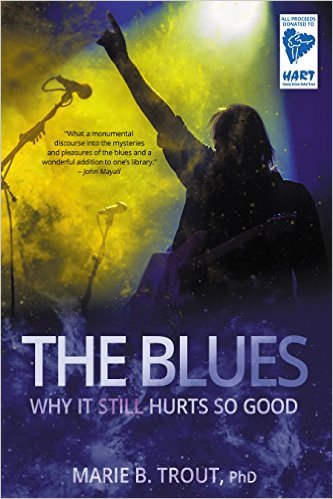 You might recognize her name. Marie Trout, PhD, is the wife of blues rock guitarist Walter Trout, who missed death by getting a liver transplant just in time. He has recovered and is back touring. During his period of suffering and recovery, Marie undertook a massive research project to try to gain an understanding of who the blues audience is today demographically and psychographically, and how it has changed over time. She has combined her research with personal experience, revealing interviews, and some rather unique stories. Mostly it reads like an academic book, providing tremendous historical insights to the 20th century and combining scientific research with qualitative material to explain why the blues has such enduring power. Like any textbook, you can’t expect to read this in one sitting. If you get bogged down in the esoteric parts, keep going, you’ll find plenty of nuggets that should interest you.
You might recognize her name. Marie Trout, PhD, is the wife of blues rock guitarist Walter Trout, who missed death by getting a liver transplant just in time. He has recovered and is back touring. During his period of suffering and recovery, Marie undertook a massive research project to try to gain an understanding of who the blues audience is today demographically and psychographically, and how it has changed over time. She has combined her research with personal experience, revealing interviews, and some rather unique stories. Mostly it reads like an academic book, providing tremendous historical insights to the 20th century and combining scientific research with qualitative material to explain why the blues has such enduring power. Like any textbook, you can’t expect to read this in one sitting. If you get bogged down in the esoteric parts, keep going, you’ll find plenty of nuggets that should interest you.
Trout surveyed over 1,000 blues fans (mostly middle-aged baby boomer whites – the core audience), as well as industry professionals and musicians. She said, “…At my lowest point, fearing ridicule and rejection, I sent my anguish out to the world asking for help in a fundraiser and accompanying blog. That day something changed: when sharing authentically, I was no longer alone in my emotional prison. When others read it, responded, and shared their own stories, I realized that this connection in many ways was similar to what blues fans expressed in my research. They felt connected and safe to be themselves, when listening to blues music: they felt part of a soul-community.”
When reviewing blues festivals, I have often commented on the “special vibe” without really digging deeper to understand it. Last year I accidentally backed my car into another and left a small dent. The driver looked at me and said, “No problem. You have a small scratch too. Don’t worry about it.” If this same incident had occurred in a shopping mall parking lot, for example, you could be sure that it would have been handled entirely differently. This is yet another example of how, as Marie explains, the common bond of sharing the blues breaks down barriers and brings out the best in people.
Let me just share a couple of memorable stories from the book that might pique your interest. Thomas Ruf, who was only 18 years old at the time, describes a night when Luther Allison was playing in a small town in Germany. The band wanted to eat after the show and Ruf persuaded a woman who owned a bar in town to keep it open late. When they walked in, some Black Forest musicians were playing. Ruf says, “And then Luther got so excited that we eating there, and after we were done eating, he jumped up: Grabbed his guitar and jumped on stage and smiled at these guys, and these guys were like 75-80 years old, old German men. Nobody spoke English. Luther didn’t speak a word of German, and he just started jamming with these guys. I just realized that this black man is probably the first black man that these old Black Forest guys ever saw.”
When describing how the sensations that can vibrate our skin are sent to the brain, inducing a trance-like state, Marie describes how Walter’s first paying gig as a sideman was for an audience of deaf people. They were requested to “turn everything all the way up.” The representative explained that if the band played loudly, the deaf people could feel the vibrations through the floor and their bodies. A great time was had by the deaf dancers who simply felt the music.
This is a remarkable body of research that delivers some very unique explanations of why the blues resonates. Even those of us who have been blues fans throughout our lives can learn much through Marie’s work.
—Jim Hynes







Be the first to comment!